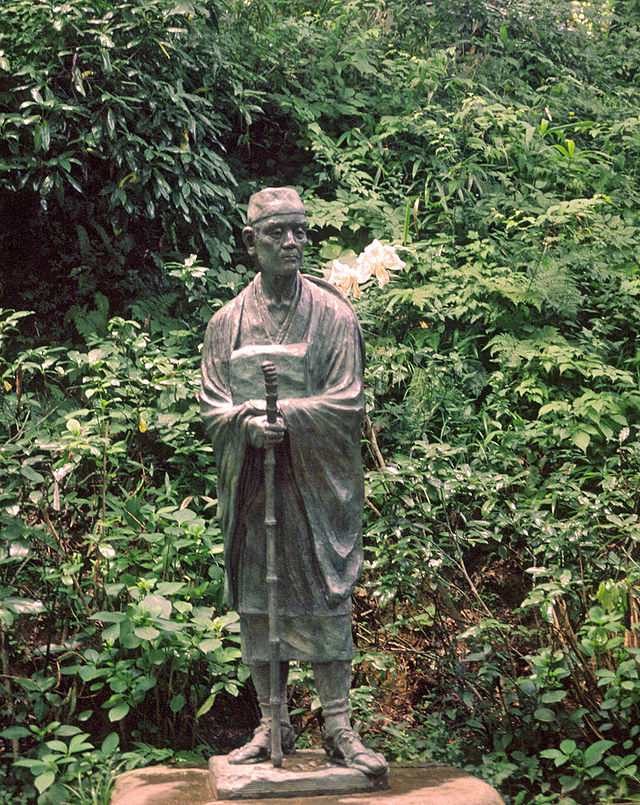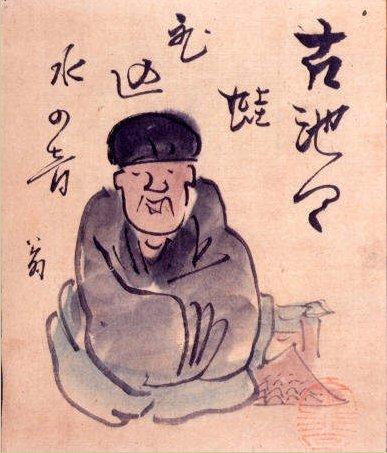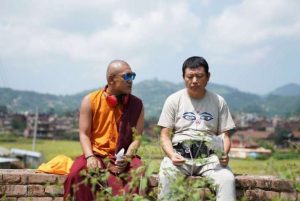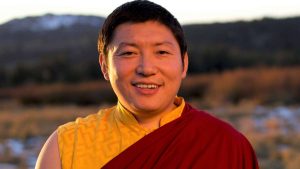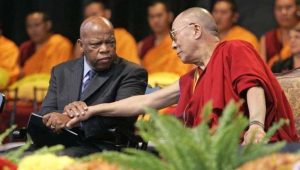Furu ike ya
kawazu tobikomu
mizu no oto
The old pond
a frog jumps in
kerplunk
Matsuo Basho’s (1644–94) haiku—that mind-altering frog vanishing into an ancient pond—has become so deeply scored in the popular imagination that it seems older than poetry itself. A hundred different translations have appeared in English. Most readers of poetry will ingest the image and hardly notice the words. Basho, dressed in mud-spattered robes, wandering 17th-century Japanese backcountry landscapes or sequestered in a tiny hut on the outskirts of Edo (modern-day Tokyo), has become as vivid a figure of folklore as of poetry. It was under his influence that haiku emerged as a poetry humble in subject and free of pretension, conveying Buddhist insights into cycles of nature and the human mind.
Basho was the poet’s pen name, taken after he’d already achieved a bit of fame. He lived on the outskirts of Edo, and got the name he is known by from a banana tree his students planted outside his hut, his Basho-an, or “banana-tree retreat.” He admired the tree for its uselessness: basho flowers are not much to look at, indelicate, not what you’d want on an altar. Japan’s northerly sea-blown climate is too raw for the tree to bear palatable fruit; you can’t make furniture of its fibrous wood. In the spirit of renunciation, and with a hint of dry humor, Basho declared haiku useless too: “a fireplace in summer, in winter a fan.” What he did appreciate the basho for was the sound when a rain squall battered its torn leaves.
Basho and his contemporaries used plain common language for haiku, separating it from the classical poetry of earlier eras—which had been high-class in tone, vocabulary, and subject matter. The frugal, democratic idiom of haiku accounts for its swift appeal to North Americans, who fancy ourselves lean in character, indifferent to luxury, and seasoned by hard work if not outright hardship. Jack Kerouac caught a spirit close to Basho’s in his lifestyle and writings, and it might be that he and his friends did for American poetry what Basho’s crew did for Japanese. Allen Ginsberg: “He’s the only one in the United States who knows how to write haiku . . . [he] talks that way, thinks that way.” Kerouac celebrated the down-home, the humble, the image so ordinary that a thousand people ignore it each day:
The windmills of
Oklahoma look
In every direction
In Japan, this aesthetic is called wabi-cha: rough-hewn, rustic, unpretentious, salted with ordinariness. As a lifestyle, think of Thoreau, salvaging old clothes, used lumber, a beaten pan. To Kerouac, poetry-mind and renunciation were not too different. Envisioning Asia’s early poets, he wrote in The Dharma Bums (1958): “I see a vision of a great rucksack revolution, thousands or even millions of young Americans wandering around with their rucksacks, going up the mountains to pray, making children laugh and old men glad. . . . Zen lunatics who go about writing poems.” Haiku writing was at the core of Zen poverty. Kerouac’s haiku captures what Basho had cultivated four hundred years earlier:
In my medicine cabinet
the winter fly
Has died of old age
Kerouac
A crow has settled
on the withered branch—
autumn dusk
Basho
The “hai” of “haiku” means “comic,” “light-hearted,” “sportive.” It suggests high-spirited play, wise irreverence, reckless spontaneity. Even when melancholy it aims for light-handed use of popular language—slang, old phrases, even weird Buddhist vocabulary. Haiku developed out of a highly formal, collaborative verse called renga, popular at gatherings among Japan’s prosperous middle class during the 17th century. The group would compose a poetry sequence, verse by verse, link by link. Invented on the spot, renga developed complicated rules. Handbooks collected the rules: which verses you wrote the moon into, when to address love, seasons, flowers, travel. Raucous in tone, brimming with coarse humor and put-downs, renga rarely resulted in fine poetry except when sessions included a master poet. Stories are told of a thousand people participating in one writing session: drinking party, poetry slam, word cleverness. It was from these party-like occasions that haiku was hatched.
Guests would arrive at a renga session each with a 17-syllable verse, called “hokku,” hoping their stanza might be chosen to open the poem the group would write. Only one hokku would be selected at such gatherings, and poets began to accumulate opening verses, the unused ones (I picture dedicated renga party-goers ending up with rucksacks full). Some people then started to see these orphan stanzas as poems in their own right, and later called them “haiku”—a neologism compounded of the terms “hai” and “hokku.” However, the word itself did not become common until the 20th century.
Haiku flourished in Japan during the Edo period (1615–1868), a time of newly opened trade, entertainment, and urban excitement. A prosperous middle class was emerging. In the cities, merchants, and in the towns, agrarian people, fostered education; literacy became exhilarating and widespread. It was among the newly literate that haiku arose, a middle-class effort to take part in Japanese culture. Merchant and military classes, reading and writing, took on themes and practices of the arts that had formerly been restricted to the aristocracy. In the hands of samurai and onion farmer, sake merchant and potter, haiku introduced a riot of possibilities: street words, colloquialisms, Chinese compounds, Buddhist terms, pop slogans all went into poetry. They cut free from stodgy topics—frail romantic women in sumptuous brocade gave way to scarecrows, radishes, snails. They chucked out obsolete themes of the imperial court.
“The old verse can be about willows,” Basho told his students. He was gazing back across Japan’s long tradition of court poetry. “Haiku requires crows plucking snails in the rice paddy.”
Yet—greatly due to Basho’s influence—haiku’s jostling language came to be imbued with profound silences and great open spaces. The effect of Basho’s “old pond and frog” haiku comes from a gut feeling that the silence over the pond has been made solid, deepened by the sound of the frog; as the “kerplunk” dies away, the old rock walls lining the pond, the gnarled tree, the reeds, expose their self-nature.
There is something unforgettable in the best haiku image. The old crow, the fly in the medicine cabinet, linger on, long after the words are exhausted or forgotten. This is why haiku holds the flavor of Zen: from one essential detail, a sudden direct view of the great Void. Haiku is too brief for description, bombast, abstraction, philosophy, sermonizing. Its effect is closer to magic, to mantra. To those brought up on traditional Western poetry, what a relief to leave prophecy, history, and big ideas behind! Haiku is the “rucksack” form of poetry; its practice has come to seem a pilgrimage, an outward journey that is vividly inward.
For haiku, spontaneity may not be the single most important value (it surprises many to discover how much revision Basho could put into a single verse, sometimes refining a haiku for six months until he felt he’d got it); but haiku that doesn’t carry a good whiff of freedom, innovation, or vivid surprise falls pretty flat. Basho’s aphorism has echoed down the years: “Don’t follow in the footsteps of the old poets, seek what they sought.” Three centuries later, Kerouac provided an American insight: “POP-American (non-Japanese) Haikus, short 3-line poems or ‘pomes’ rhyming or nonrhyming delineating ‘little Samadhis’ if possible, usually of a Buddhist connotation, aiming towards enlightenment.” Basho, who wore patchwork monk robes and had studied the old Zen teachings first-hand, would have remained silent on whether haiku’s target was enlightenment. He used the term furabo, or “poetic intensity.”
A requirement for haiku has been that each evokes a specific season. The celebrated anthologies in Japanese, English, and other languages are arranged by season. This close attention to nature yields a view of the transitory quality of life. Here lies the moon-in-a-dewdrop of Buddhist teachings, Kerouac’s “little Samadhis.” Japanese poets, studying the changes of nature, referred to life as the “floating world”; sometimes “this floating bridge of dreams.” How curious that the old human dream of some eternal, underlying substance gives way with a little bit of nature-watching to a bridge of dreams, a floating world.
And what lies behind the dream? Buddhism has in its view of existence no creator figure, no power or intelligence orchestrating events on earth, no heaven, no destination. There is, it seems, no meaning behind existence to figure out, not in nature, not in the poem. Life does not point to something beyond.
If haiku points to no higher meaning, what makes a good poem seem vast, wise? So rounded by silence? So full of rock solid insight? “It’s there,” says Kerouac, “& nothing you can say or do about it, except look in dismay at the power of looking.” This actual moment! That bedraggled crow! This moonlit evening, that cold rain on your skull!
There you stand, inhabiting your body, alert as an animal, senses wide open. No abstract idea touches what you see, or what the poem sees. Buddhists call this experience of bedrock, unmediated presence, tattva, “thusness.” “No ideas but in things,” William Carlos Williams famously wrote in his modernist epic Paterson, setting ten thousand poems free from abstraction. This could be Basho as well: “To know the pine, go to the pine. To know the bamboo, go to the bamboo.”
References
Hass, Robert, ed. 1994. The Essential Haiku: Versions of Basho, Buson, & Issa. Hopewell, New Jersey: The Ecco Press.
Kerouac, Jack. 1958. The Dharma Bums. New York: The Viking Press.
———. 2003. Book of Haikus. New York: Penguin Poets.
Williams, William Carlos. 1992. Paterson. New York: New Directions Publishing.
Andrew Schelling is a poet and translator. Recent titles include The Real People of Wind & Rain: Talks, Essays, & an Interview (2014) and an anthology, Love and the Turning Seasons: India’s Poetry of Spiritual and Erotic Longing (2014). He teaches at Naropa University in Boulder, Colorado, as well as at Deer Park Institute and The Public School of Oakland.





